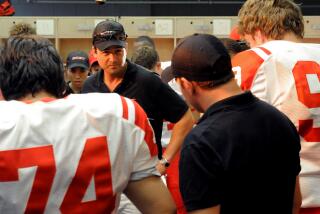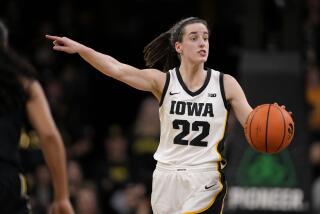George Mason Does It With Fun
- Share via
By all rights, I should be mad at the George Mason Patriots. They’re the ones who destroyed my shot at winning the tournament pool by beating my championship pick, Connecticut. They made me more wrong about predicting a game than I’ve ever been before. And it’s their fault I can’t get “Livin’ on a Prayer” out of my head.
I never did like Bon Jovi.
Instead, I find myself embracin’ the Mason, falling for the team that disproved everything I thought I knew about basketball.
I still believe it’s a simple game. Score, stop the other team from scoring, score in crunch time. If you can do those three things, you’ll win. But it almost always takes talent to do those things, and the more games played, the more that talent asserts itself.
Conventional thinking is that if you’re going to win NCAA tournament games in late March and early April then, as Washington assistant Cameron Dollar put it, “You better have some lottos.”
As in NBA lottery picks. Pro-caliber players can overcome mistakes and adversity. They can do things the average collegian just can’t.
I watched 11th-seeded George Mason beat Wichita State last Friday. I was impressed with the Patriots’ ability to rotate and find the right place on defense, and their patience on offense. But I didn’t see any future pros out there. With the exception of guard Folarin Campbell, all of the George Mason players are undersized for their position.
And when top-seeded Connecticut faced Washington afterward, the pace and intensity made George Mason-Wichita State look like a JV game. If Connecticut’s collection of Rudy Gay, Marcus Williams, Josh Boone, Hilton Armstrong and Co. could overcome 26 turnovers against a Washington team with players as good as Brandon Roy and Jamaal Williams, there was no way George Mason could beat them.
Teams seeded first or second in their region won 20 of the 27 tournaments since the seeding process began in 1979. Upsets are for the first weekend of the tournament, not the second.
“That first round the whole story is about David vs. Goliath,” George Mason Coach Jim Larranaga said. “But David hasn’t won the national championship.”
Only once before had a truly Davidian team -- as in a double-digit seeding -- even reached the Final Four: 11th-seeded Louisiana State in 1986.
The NCAA Final Four records book defines an upset as a victory by a team seeded at least five places below the loser. By that definition, in the previous 17 tournaments there had been only three upsets in the Sweet 16 and beyond -- and one of those was by Michigan’s ultra-talented Fab Five freshman class in 1992.
As top-seeded Connecticut Coach Jim Calhoun said, “I’d always rather be playing from the top, because generally speaking you’re always going to have a couple of weapons that can get you to where you want to be.”
So those were the heavy practical and historical obstacles the Patriots faced. But from the moment they arrived at Washington D.C.’s Verizon Center they always appeared excited about their opportunity. It was as if they were taking a White House tour and the President invited them into the Oval Office to pose for pictures.
“This group is great,” forward Jai Lewis said. “We just try to have fun. We don’t want to be stiff all the time. We try to have fun.”
So does the Patriots’ coach, who is savoring every moment and doing interviews until he literally nods off mid-question from lack of sleep.
The fans might be enjoying this ride more than anybody. I’ve never seen players as connected with and reflective of their supporters. Sometimes the groups might as well be from two different countries. For example, Duke players never bothered me as much as their obnoxious fans and their sense of entitlement did.
But George Mason’s fans set the right atmosphere from the beginning of the weekend’s first game, singing along as the band played what’s become the school theme song, “Livin’ on a Prayer.” The players made a habit of looking over or pointing at them when they made big plays.
Lamar Butler made a habit of smiling. I think he can’t help it. When he was fouled while making a three-point basket against Connecticut, he looked tough, glared at a teammate and yelled, “And one, boy!” Then, instinctively, he broke into a grin.
After the game, his father explained why this has been such a joyride for his son.
“Education is the most important thing,” Lamar Butler Sr. said. “He got [his diploma] in December. Anything after that is gravy.”
Everyone you talk to on this team puts things in perspective. I teased forward Will Thomas that he and Lewis have the slowest low-post moves I’ve ever seen. (They’re as drawn-out as the latest “Sopranos” episodes.) Thomas shrugged.
“I think it’s just taking our time,” Thomas said. “When you rush, you tend to miss shots.”
So in that spirit let’s slow down and take our lessons from George Mason.
We’re so consumed with why things are this way, we can’t open our minds to why there might be another. Who’s to say a team that’s in the right place defensively and works the ball outside-to-inside-to-outside on offense can’t beat anyone in its path?
Sometimes you’re better off getting rid of most of the things you know. That’s what Larranaga took from a meeting with former Wisconsin Green Bay coach Dick Bennett years ago. Larranaga came to him with a notebook filled with 108 pages of his thoughts on basketball. Bennett told him he needed only one page.
“I went back and put the notebook aside and spent the better part of the next two years trying to get everything on one page,” Larranaga said. “And once I did I was so much more at peace with myself as a coach and what I stood for than I had been at any other point in my career.”
That’s what I’ve done. I’ve thrown away the book on conventional wisdom, dared to think that these Patriots might just win the whole thing. With Connecticut out, I don’t have any financial stake left.
Besides, I became so enamored with George Mason, I didn’t even mind if it cost me a few Ben Franklins.
J.A. Adande can be reached at [email protected]. To read more by Adande
go to latimes.com/adandeblog.
More to Read
Go beyond the scoreboard
Get the latest on L.A.'s teams in the daily Sports Report newsletter.
You may occasionally receive promotional content from the Los Angeles Times.










